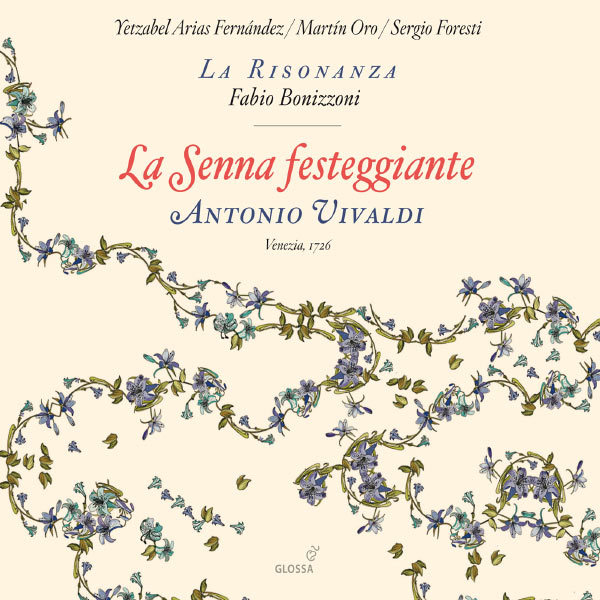
Composer: Antonio Vivaldi
Performer: La Risonanza, Yetzabel Arias Fernández, Martín Oro, Sergio Foresti, Fabio Bonizzoni
Conductor: Fabio Bonizzoni
Format: FLAC (tracks)
Label: Glossa
Catalogue: GCD921513
Release: 2012
Size: 388 MB
Recovery: +3%
Scan: yes
La Senna festeggiante, RV 693
Part I
01. Sinfonia: Allegro –
02. Sinfonia: Andante molto –
03. Sinfonia: Allegro molto
04. Della Senna in su le sponde (L’Eta dell’Oro, La Virtu, La Senna)
05. Recitative: Io, che raminga errante (L’Eta dell’Oro)
06. Aria: Se qui pace tal’hor va cercando (L’Eta dell’Oro)
07. Recitative: Anch’io raminga errando (La Virtu)
08. Aria: In quest’onde (La Virtu)
09. Recitative: Illustri amiche (La Senna)
10. Aria: Qui nel profonde del cupo fondo (La Senna)
11. Recitative: Si, si, gia che tu brami (L’Eta dell’Oro, La Virtu)
12. Duet: Godrem fra noi la pace (L’Eta dell’Oro, La Virtu)
13. Recitative: Tutto muor, tutto manca (La Senna, La Virtu, L’Eta dell’Oro)
14. Aria: Vaga perla benche sia dell’Aurora bianca figlia (La Virtu)
15. Recitative: Tal di me parla ancora (L’Eta dell’Oro)
16. Aria: Al mio seno il pargoletto (L’Eta dell’Oro)
17. Recitative: Della ferrea stagion (La Virtu, L’Eta dell’Oro)
18. Duet: Qui per darci amabil pace – Per goder l’antica pace (L’Eta dell’Oro, La Virtu)
19. Recitative: Ma rimirate amiche (La Senna)
20. Aria: L’alta lor gloria immortale (La Senna)
21. Recitative: O, di qual melodia (L’Eta dell’Oro, La Virtu, La Senna)
22. Di queste selve venite o Numi (L’Eta dell’Oro, La Virtu, La Senna)
Part II
23. Overture: Adagio – Presto – Allegro molto
24. Recitative: Ma gia ch’unito in schiera (La Senna)
25. Aria: Pieta, dolcezza, fanno il suo volto (La Senna)
26. Recitative: Non si ritardi (L’Eta dell’Oro, La Virtu)
27. Aria: Stelle, con vostra pace (La Virtu)
28. Recitative: Vedrete in quest’eroe (La Senna, L’Eta dell’Oro, La Virtu)
29. Duet: Io que pravo si caro diletto – Qui nel seno ho si tenero affetto (L’Eta dell’Oro, La Virtu)
30. Recitative: Quanto felici siete (La Virtu)
31. Aria: Giace languente (L’Eta dell’Oro)
32. Recitative: Quanto felici siete (L’Eta dell’Oro)
33. Aria: Cosi sol nell’aurora (La Virtu)
34. Recitative: Mo giunti eccone innante (La Senna, La Virtu, L’Eta dell’Oro)
35. Aria: Non fu mai piu vista in soglia (L’Eta dell’Oro)
36. Recitative: Per tributarti ancella (L’Eta dell’Oro)
37. Il destino, la sorte e il fato (L’Eta dell’Oro, La Virtu, La Senna)
Continuing his captivating survey of the Baroque serenata, Fabio Bonizzoni now focuses on one of the “occasional” works – with music at a magnificently-high level throughout – written by Antonio Vivaldi when in Venice: ‘La Senna festeggiante’.
What animated Vivaldi to compose a work apparently extolling the virtues of the River Seine in Paris? The story goes, as described by Michael Talbot in his exemplary accompanying essay, that the serenata was written in 1726 jointly to honour the French king, Louis XV (on his name day), Cardinal Pietro Ottoboni (then the Protector of the Affairs of France at the Vatican) and the French Ambassador in Venice, the Comte de Gergy; and bringing in the river to heap Baroque praise on the Sun King’s great-grandson.
An unmistakeably Vivaldian score (complete with self-borrowings and “loans” from others), the composer nonetheless makes plentiful musical allusions to his Gallic theme and setting through the music of the three named vocalists – The Golden Age, Virtue and the Seine – and through the instrumental accompaniment, handled deftly and gloriously here by Bonizzoni and La Risonanza. The singers, Yetzabel Arias Fernández, Martín Oro and Sergio Foresti, capture the spirit of the allegorical and fluvial characters superbly in this new Glossa recording, which was made at the Abbaye de Saint-Michel en Thiérache (also the setting for La Risonanza’s earlier recording of Alessandro Scarlatti’s Serenate a Filli).